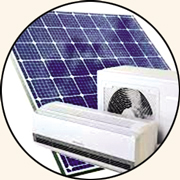
Exploiting benefits of solar air conditioners
Syed Mansur Hashim | Saturday, 8 June 2024
 The market of hybrid solar air conditioner is growing globally. As the world turns hotter, the demand for air conditioners has also gone up in Bangladesh along with other tropical countries. With the constant revision of power prices (upward) in the country, electricity bills have become a major headache for most people. There is a desperate need for a more affordable solution to energy consumption at not just household, but also commercial and industrial level. Rooftop solar panels are increasingly becoming visible at factory-level, but there is great potential for expanding that idea to all urban centres where a sizeable portion of the working population lives.
The market of hybrid solar air conditioner is growing globally. As the world turns hotter, the demand for air conditioners has also gone up in Bangladesh along with other tropical countries. With the constant revision of power prices (upward) in the country, electricity bills have become a major headache for most people. There is a desperate need for a more affordable solution to energy consumption at not just household, but also commercial and industrial level. Rooftop solar panels are increasingly becoming visible at factory-level, but there is great potential for expanding that idea to all urban centres where a sizeable portion of the working population lives.
With easier terms of payments made possible through zero interest instalment payments, the middle class in Bangladesh (the largest consumer section) are rushing to buy air conditioners. Inverter-type split air conditioners promise to save a lot of electricity from non-inverter types, but the fact remains that in an import-driven, fossil-fuel powered energy sector, utility bills will inevitably be itching upward every year. This has given rise to technological innovation which calls for a hybrid air conditioner design, which is being developed and increasingly utilised by power-hungry, highly populated economies like China, India, etc. Indeed, market data suggest that given proper regulatory incentives, tax breaks on import of key components, the global market for such air conditioners could be worth as much as US$500 million by 2025.
The system is a combination of traditional air conditioning type (split-type) with solar panels in an effort to reduce both energy consumption and environmental impact. The Asia-Pacific region will be the focal point of this growth because of the large concentration of people living in the region that smarts under high temperatures practically throughout the year. Challenges faced by the market include higher initial costs and limited awareness among consumers. Regulatory and legal factors specific to market conditions include government policies promoting renewable energy adoption and regulations for energy efficiency standards. Overall, the market of hybrid solar air conditioner shows promising growth potential with the right support and innovation.
This type of air conditioner has applications for off-grid operation, which could provide a huge bonanza for local manufacturers/assemblers. It would provide a lifeline for domestic battery manufacturers and could potentially open up the market for joint-ventures with foreign companies that would involve technology transfer and setting up of plants in the export processing zones to produce key components (like inverters) that constitute the architecture for the hybrid system. There is no point in manufacturing solar panels in Bangladesh. The cost-benefit analysis does not favour Bangladesh since there are global players who have driven down the cost significantly over the years.
Market research reports suggest that the market of hybrid solar air conditioner is growing due to increasing environmental awareness and rising energy costs. Market dynamics for ASEAN and China are naturally different from that of Bangladesh since the peoples of those regions boast much higher incomes than in Bangladesh. Yet the demand for air conditioners cannot be discounted in this market, especially since several manufacturers are now present in the domestic market who are in the process of localising production of key components of an air-conditioning system - leading to reduced pricing and making systems much more affordable, thus driving up demand.
However, to make a transition from ordinary AC or DC air conditioners to solar hybrid, government support is essential. It requires government-driven energy incentives. Bangladesh already has the Sustainable and Renewable Energy Development Authority (SREDA), a body that can fulfil this role by keeping tabs on technological advancement in development of smart thermostats made in advanced economies. The SREDA can help government frame policy guidelines for the faster adoption of the technology which has to start with public buildings to serve as a testbed for technology demonstration for wider implementation at industrial, commercial and residential levels. The good news is that this technology can covert certain types of normal Acs to the solar type. That opens up a much bigger market and certainly would go a long way for people to save money on utility bills. It could also pave the way for major savings for government as energy savings could be cut by half in this segment as sunlight is available at least 10-12 hours of the day during summertime.
It is not simply about reducing energy bills but also reducing the carbon footprint. Regardless of what the powerful energy cartels say or do in Bangladesh, the country is struggling due to a huge foreign exchange crisis. The economy is in the midst of serious contraction and a lot of it has to do with the burgeoning fossil-fuel import bill. Hence, energy conservation, efficiency and reduced consumption of energy produced from fossil fuels are areas that have to be explored.
mansur.thefinancialexpress@gmail.com